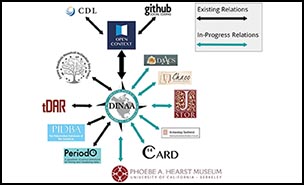Crossref Citations
This article has been cited by the following publications. This list is generated based on data provided by
Crossref.
Murtha, Timothy M.
Lawres, Nathan R.
Mazurczyk, Tara J.
and
Brown, Madeline
2019.
Investigating the Role of Archaeological Information and Practice in Landscape Conservation Design and Planning in North America.
Advances in Archaeological Practice,
Vol. 7,
Issue. 4,
p.
382.
LeFebvre, Michelle J.
Brenskelle, Laura
Wieczorek, John
Kansa, Sarah Whitcher
Kansa, Eric C.
Wallis, Neill J.
King, Jessica N.
Emery, Kitty F.
Guralnick, Robert
and
Lozano, Sergi
2019.
ZooArchNet: Connecting zooarchaeological specimens to the biodiversity and archaeology data networks.
PLOS ONE,
Vol. 14,
Issue. 4,
p.
e0215369.
Wu, Yongxing
Lin, Shaofu
Peng, Fei
and
Li, Qi
2019.
Methods and Application of Archeological Cloud Platform for Grand Sites Based on Spatio-Temporal Big Data.
ISPRS International Journal of Geo-Information,
Vol. 8,
Issue. 9,
p.
377.
Davis, Dylan S.
2020.
Geographic Disparity in Machine Intelligence Approaches for Archaeological Remote Sensing Research.
Remote Sensing,
Vol. 12,
Issue. 6,
p.
921.
Heilen, Michael
2020.
The Role of Modeling and Synthesis in Creative Mitigation.
Advances in Archaeological Practice,
Vol. 8,
Issue. 3,
p.
263.
Cook Hale, Jessica W.
and
Sanger, Matthew
2020.
Cultural spaces and climate change: Modeling Holocene archaeological settlement patterns on the coastal plain of the southeastern United States.
Journal of Anthropological Archaeology,
Vol. 59,
Issue. ,
p.
101198.
Wan, Lunyu
2021.
Digital Web Archive Collection Framework Based on Intelligent Management Information System and Optimization.
p.
1.
Holland-Lulewicz, Jacob
2021.
From Categories to Connections in the Archaeology of Eastern North America.
Journal of Archaeological Research,
Vol. 29,
Issue. 4,
p.
537.
Nicholson, Christopher
Fernandez, Rachel
and
Irwin, Jessica
2021.
Digital Archaeological Data in the Wild West: the challenge of practising responsible digital data archiving and access in the United States.
Internet Archaeology,
Ritchison, Brandon T.
and
Anderson, David G.
2022.
Following the Mississippian Spread.
p.
257.
Miller, D. Shane
and
Carmody, Stephen B.
2022.
Fire on the Mountain: The Ideal Free Distribution and Early Hunter-gatherer Demography in the Tennessee River Drainage, USA.
Environmental Archaeology,
Vol. 27,
Issue. 4,
p.
357.
Schmidt, Sophie C.
Thiery, Florian
and
Trognitz, Martina
2022.
Practices of Linked Open Data in Archaeology and Their Realisation in Wikidata.
Digital,
Vol. 2,
Issue. 3,
p.
333.
Wernke, Steven A.
Van Valkenburgh, Parker
Zimmer-Dauphinee, James
Whitlock, Bethany
Spence Morrow, Giles
Smith, Ryan
Smit, Douglas
Roque Ortega, Grecia
Ricci Jara, Kevin
Plekhov, Daniel
Oré Menéndez, Gabriela
Norman, Scotti
Marcone, Giancarlo
Mamani Calloapaza, Manuel
Kohut, Lauren
Hernández Garavito, Carla
Chacaltana-Cortez, Sofia
and
Arkush, Elizabeth
2024.
Large-scale, collaborative imagery survey in archaeology: the Geospatial Platform for Andean Culture, History and Archaeology (GeoPACHA).
Antiquity,
Vol. 98,
Issue. 397,
p.
155.
Neller, Angela
Heckman, Jasmine
Bollwerk, Elizabeth
Myers, Kelsey Noack
and
Wells, Josh
2024.
Making Archaeological Collections More Findable and Accessible through Increased Coordination.
Advances in Archaeological Practice,
Vol. 12,
Issue. 1,
p.
34.
Anderson, David G.
2024.
Modern archaeological research and the importance of information management.
Proceedings of the National Academy of Sciences,
Vol. 121,
Issue. 16,
Freeman, Jacob
Robinson, Erick
Bird, Darcy
Hard, Robert J.
Mauldin, Raymond P.
and
Anderies, John M.
2024.
The long-term expansion and recession of human populations.
Proceedings of the National Academy of Sciences,
Vol. 121,
Issue. 12,


